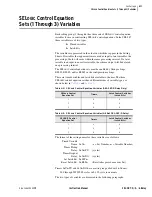
4.23
Date Code 20050919
Instruction Manual
SEL-387-0, -5, -6 Relay
Control Logic
Trip and Close Logic
Figure 4.8
SEL-387 Close Logic (CLS1)
The logic begins with the assertion of SEL
OGIC
control equation CL1, one of
the Group variables. In our example application, CL1 = CC1 + /IN104. Thus,
CL1 will assert either if (1) a
CLO 1
command has been sent to the relay via a
serial port, or if (2) input
IN104
has been energized via an external SCADA,
recloser, or control switch contact, for example. CL1 does not directly assert
CLS1 but acts as one input to the AND gate at the center. The other input to
the AND gate is a negated OR gate output which asserts whenever any of the
unlatching functions is in effect. Thus, unlatch elements take precedence over
the close command elements.
Assuming no unlatch elements are asserted, assertion of CL1 produces
assertion of the output Relay Word bit CLS1. CLS1 seals itself in via the OR
gate at the top and begins to drive the output contact OUT105 (=CLS1),
leading to the Breaker 1 closing circuit. CLS1 can also be used in other
SEL
OGIC
control equations. CLS1 will remain asserted, and
OUT105
will
remain closed, until the close logic is unlatched by one of three means:
assertion of the ULCL1 setting, closure of the breaker 52a auxiliary contact,
or a Close Failure Detection. These three functions are inputs to the OR gate
at the mid-left.
The ULCL1 SEL
OGIC
control equation setting defines conditions for
unlatching the close logic. If CL1 is not asserted when ULCL1 asserts,
ULCL1 effectively “blocks” the close logic. If CL1 should assert after ULCL1
has been asserted, it effectively will be ignored, and CLS1 will not assert. If
CL1 has asserted before ULCL1 and the closing process has begun, assertion
of ULCL1 will unseal CLS1 and interrupt the process. In our example,
ULCL1 = TRIP1 + TRIP4. That is, if a Winding 1 overcurrent trip, or a high-
speed differential trip has been initiated, ULCL1 will prevent the close
process from starting, or it will prevent it from going to completion if it has
already begun.
Under normal circumstances, the second means of unlatching occurs. This is
the closure of the Breaker 1 52a contact. The close logic setting 52A1 =
IN101. When CLS1 asserts,
OUT105
closes and the breaker begins to close.
When the breaker closing is complete, the 52a contact closes, duplicating the
operation of the breaker contacts themselves, and effectively indicating that
the breaker is closed. The 52a contact is wired to
IN101
. When
IN101
asserts, the
equation 52A1 asserts and unlatches the close logic, deasserting CLS1 and
opening
OUT105
. The close process is now complete. (Presumably, interruption
of the current in the closing circuit has been accomplished via a breaker 52b
contact, and not by
OUT105
.)
Relay
Word
Bits
CLS1
Close
Failure Timer
CF1T
0
CFD
Logical 1 (setting CFD
≠
OFF;
Close Failure Timer Operative)
Close Failure Timer Inoperative)
Logical 0 (setting CFD = OFF;
CL1
ULCL1
52A1
Pulses
(logical 1) for
one processing
interval if
Close Failure
Timer times out
rising
edge detect
SEL
OGIC
Control
Equation Settings
Содержание SEL-387-0
Страница 10: ...This page intentionally left blank ...
Страница 16: ...This page intentionally left blank ...
Страница 56: ...This page intentionally left blank ...
Страница 350: ...This page intentionally left blank ...
Страница 388: ...This page intentionally left blank ...
Страница 456: ...This page intentionally left blank ...
Страница 494: ...This page intentionally left blank ...
Страница 528: ...This page intentionally left blank ...
Страница 536: ...This page intentionally left blank ...
















































